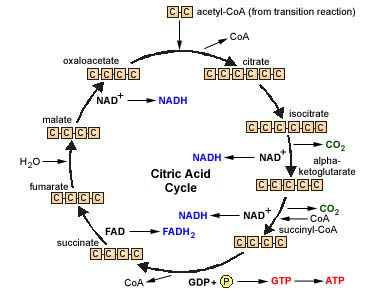
1. Before the pyruvates from glycolysis
can feed into the citric acid cycle, they must undergo a transition reaction.
The pyruvate is converted into a 2-carbon acetyl group as the third carbon is
lost as CO2. The acetyl group is attached
to coenzyme A to form acetyl-CoA.
2. The 2-carbon acetyl-CoA combines with the 4-carbon oxaloacetate of the citric
acid cycle to form 6-carbon citrate.
3. Citrate is converted to isocitrate.
4. The 6-carbon isocitrate is oxidized by NAD+ to produce reduced
NADH and 5-carbon alpha-ketoglutarate. (One carbon is lost as CO2.)
5. The 5-carbon alpha-ketoglutarate is oxidized by NAD+ to produce
reduced NADH and 4-carbon succinyl-CoA. (One carbon is lost as CO2.)
6. Oxidation of succinyl-CoA produces succinate and one GTP that is converted
to ATP.
7. Oxidation of succinate by FAD produces reduced FADH2
and fumarate.
8. Fumarate is converted into malate.
9. Oxidation of malate by NAD+ produces reduced NADH and oxaloacetate.
The two molecules of acetyl-CoA from the transition reaction enter the citric acid cycle. This results in the formation of 6 molecules of NADH, two molecules of FADH2, two molecules of ATP, and four molecules of CO2. The NADH and FADH2 molecules then carry electrons to the electron transport system for further production of ATPs by oxidative phosphorylation.